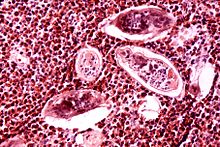Schistosoma haematobium
| Schistosoma haematobium | |
|---|---|
 |
|
| Histopathology of bladder shows eggs of Schistosoma haematobium surrounded by intense infiltrates of eosinophils. | |
| Scientific classification | |
| Kingdom: | Animalia |
| Phylum: | Platyhelminthes |
| Class: | Trematoda |
| Subclass: | Digenea |
| Order: | Prosostomata |
| Family: | Schistosomatoidea |
| Genus: | Schistosoma |
| Species: | S. haematobium |
| Binomial name | |
|
Schistosoma haematobium (Bilharz, 1852) |
|
Schistosoma haematobium is an important digenetic trematode, and is found in Africa and the Middle East. It is a major agent of schistosomiasis; more specifically, it is associated with urinary schistosomiasis.
Adults are found in the venous plexuses around the urinary bladder and the released eggs travels to the wall of the urine bladder causing haematuria and fibrosis of the bladder. The bladder becomes calcified, and there is increased pressure on ureters and kidneys otherwise known as hydronephrosis. Inflammation of the genitals due to S. haematobium may contribute to the propagation of HIV. Studies have shown the relationship between S. haematobium infection and the development of squamous cell carcinoma of the bladder.
The free swimming infective larval cercariae burrow into human skin when it comes into contact with contaminated water. The cercariae enter the blood stream of the host where they travel to the liver to mature into adult flukes. In order to avoid detection by the immune system inside the host, the adults have the ability to coat themselves with host antigen After a period of about three weeks the young flukes migrate to the urinary bladder veins to copulate. The female fluke lays as many as 30 eggs per day which migrate to the lumen of the urinary bladder and ureters. The eggs are eliminated from the host into the water supply with micturition. In fresh water, the eggs hatch forming free swimming miracidia which penetrate into the intermediate snail host(Bulinus spp., e.g. B. globosus, B. forskalii, B. nyassanus and B. truncatus). Inside the snail, the miracidium sheds it epithelium and develops into a mother sporocyst. After two weeks the mother begins forming daughter sporocysts. Four weeks after the initial penetration of the miracidium into the snail furcocercous cercariae begin to be released. The cercariae cycle from the top of the water to the bottom for three days in the search of a human host. Within half an hour the cercariae enter the host epithelium.
...
Wikipedia
